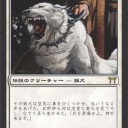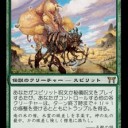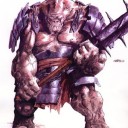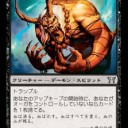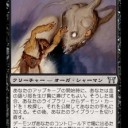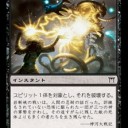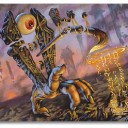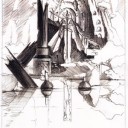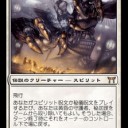The Finalist – Controlling Combo
Controlling combo decks have always been a favorite of mine since the good old High Tide days. Greg Jacob has presented a controlling combo deck that uses Cunning Wishes to go for the kill. Here’s what he has to say about the deck:
It’s a simple combo deck. The combo is an infinite mana engine using Uyo, Silent Prophet, Heartbeat of Spring and Journey of Discovery. I’ve added a bunch of Extended legal support cards but the combo is in Standard so it could be done in Standard. I’m sure the combo is fairly obvious but, here goes. With Uyo and Heartbeat of Spring in play you cast Journey of Discovery to put two lands into play, then tap two lands for 4 mana and return them to hand to copy, netting 2 mana, resolve the copy, tap the lands put into play to make a copy and return them to hand, gaining 2 mana. Repeat as needed. When you have enough mana you Cunning Wish for another Cunning Wish a few hundred times and cast Brain Freeze or Hunting Pack to finish.Creature (8)
4 Birds of Paradise
4 Uyo, Silent Prophet
Sorcery (4)
4 Journey of Discovery
Instant (20)
4 Brainstorm
4 Cunning Wish
3 Intuition
3 Counterspell
3 Accumulated Knowledge
3 Mana Leak
Enchantment (4)
4 Heartbeat of Spring
Land (24)
12 Forest
12 Island
60 Cards
Sideboard (15)
1 Intuition
1 Counterspell
1 Accumulated Knowledge
1 Mana Leak
4 Naturalize
1 Capsize
1 Moment’s Peace
1 Evacuation
1 Brain Freeze
1 Hunting Pack
1 Whispers of the Muse
1 Oxidize
Overall, this deck has excellent execution. I do think that some of the Wish targets could be looked into a bit more. I would probably keep the 4 Accumulated Knowledge in the main deck and put a Flash of Insight into the sideboard to Wish for if you want more card drawing. One of the great things about doing this is that you can actually get rid of one of the cards from your actual library to Wish for again.
Brain Freeze seems like a good card to use for the kill, and with an Inspiration or something similar in the sideboard, you can force a kill immediately. Inspiration doubles as another potential card drawer, even if it is fairly inefficient.
Another good pair of cards to consider for the sideboard would be Stifle and Forbid. Both of these cards can be really useful to wish for in a pinch. In the main deck, I’m not sure if I can agree with Mana Leak in a deck that is going to put out Heartbeat of Spring. Other options that are probably worth considering are Hinder, Memory Lapse, and Rewind.
Good job, Greg!
引用元
THE UYO CHALLENGE Posted in Feature on October 6, 2004
https://magic.wizards.com/en/articles/archive/uyo-challenge-2004-10-06
《沈黙の預見者、ウヨウ/Uyo, Silent Prophet》を使ったデッキリストの記事です。ここで引用したのを含め、合計4つのデッキが載っています。
基本的には、《沈黙の預見者、ウヨウ/Uyo, Silent Prophet》と《発見の旅路/Journey of Discovery》のコンボでライブラリーの土地を全て持ってきます。その後は、《突撃の地鳴り/Seismic Assault》で大ダメージを与えたり、《春の鼓動/Heartbeat of Spring》の無限マナからX火力を唱えたり、という狙いです。
なのですが、実はこの基本コンボは成立しません。MTG wikiでは以下のように指摘されています。
沈黙の預見者、ウヨウ/Uyo, Silent Prophetが出ているときにこれ(編注:発見の旅路)の双呪モードをコピーして、土地を戻す→出す→コピーするを繰り返し、ライブラリーの基本土地をすべて手札に持ってくる、ということは不可能。発見の旅路の2つ目のモードはあくまで土地のプレイに関する効果であり、歯と爪/Tooth and Nailのように直接土地を戦場に出すわけではないので、スタック上の呪文がすべて解決するまでは土地を戦場に出すことができず、コピー能力のためのマナを供給し続けることはできないからである。
引用元
http://mtgwiki.com/wiki/%E7%99%BA%E8%A6%8B%E3%81%AE%E6%97%85%E8%B7%AF/Journey_of_Discovery
という訳で、この特集記事のコンボデッキはすべて瓦解してしまいます。なんとも残念な結末ですが、このようなミスは誰にでもあります。
ちなみに、スタンダード以外になりますが、《発見の旅路》を別のカードに代えれば、土地を場にサーチしきることは可能であることも、MTG wikiに記載されています。
下記コラム「The Uyo Challenge」で紹介されている発見の旅路/Journey of Discoveryとのコンボは不可能である。詳細は発見の旅路/Journey of Discoveryを参照。砕土/Harrowや、スカイシュラウドの要求/Skyshroud Claim(森限定)ならば可能になる。
引用元
http://mtgwiki.com/wiki/%E6%B2%88%E9%BB%99%E3%81%AE%E9%A0%90%E8%A6%8B%E8%80%85%E3%80%81%E3%82%A6%E3%83%A8%E3%82%A6/Uyo,_Silent_Prophet
これであれば、《春の鼓動》とで大量マナ生成が可能です。
統率者戦で《沈黙の預見者、ウヨウ》デッキを組む際の参考になるかもしれません。
2021/03/09 追記
日本語訳を発見しました。
ウヨウ・チャレンジ――読者投稿《沈黙の預言者、ウヨウ》デッキ
https://web.archive.org/web/20041023052202/http://www.hobbyjapan.co.jp/magic/articles/files/20041015_02.html
神河当時 - Magic Onlineへの実装
2020年7月14日 Magic: The GatheringIntroducing Rachel Reynolds
IntoTheAether: Alan says that he starts on the "complex" cards, you start on the "straightforward" cards, and then the two of you meet at the middling cards. Is this accurate?
RachelR: Yeah, that’s about right - it usually means I program about 90% of the cards, some of which are fairly difficult, but not too terrible. For Champions, Alan programmed the splice cards, the flip cards, the new legend and targetting rules, Time Stop, Struggle for Sanity, Takeno, Sensei Golden Tail, and Sideswipe. I think I programmed pretty much everything else.
IntoTheAether: What was the trickiest card for you to code in Champions of Kamigawa and why?
RachelR: Two cards stick out in my mind:
The last card I programmed was Swirl the Mists, and since I start with the easiest ones and work up, it was likely to be tricky. I had never programmed a continuous effect with this level of complexity, as most of them tend to either only affect one card or just make simple modifications like +1/+1. After procrastinating as long as possible, implementing it was easier than I expected. My first attempt at coding it crashed the game, my second attempt only worked for one color, and the third attempt worked like a charm. I was done with the set and extremely happy!
Another card I found tricky was Imi Statue. I started that card, got frustrated with it, and went back to something else multiple times. The combination of Imi Statue, Static Orb and optional untap cards like Vedalken Shackles kept making my head spin. Eventually, I just resolved to sit down and hammer it out, and it turned out to not be as bad as I thought.
引用元
MEN, VEDALKEN, AND RACHELR Posted in Feature on October 5, 2004
https://magic.wizards.com/en/articles/archive/men-vedalken-and-rachelr-2004-10-05
記事の前半はトライバル・ウォーズの話です。ただ、神河に関する話はほとんどないので飛ばします。
後半では、Magic Online (MO) プログラマーの Rachel Reynolds へのインタビューが掲載されています。
気になったのは、MOに『神河物語』を実装する上での話です。伝説ルールの変更、連繋や反転や《時間停止/Time Stop》などの特殊な挙動、といったように、単純にカードのデータを追加する以外の仕事も多かったようです。
中でも、《渦巻く霧/Swirl the Mists》と《忌みの像/Imi Statue》の2枚がトリッキーだったと語っています。
前者は、「色を指定する言葉」を置き換えるという複雑な継続的効果なので、先延ばしにしてしまったほどです。
後者は、それ単体では(当時としては)珍しくもないアンタップ制限ですが、他の同類カード《静態の宝珠/Static Orb》との相互作用は苦心したようです。
こういう裏方の話は中々目にすることがありません。興味深い話でした。
神河当時 - スピリット・コンボ
2020年7月13日 Magic: The GatheringThe mortals of the plane of Kamigawa are at war with its kami -- and there are kami everywhere and in everything! That’s of course bad for Kamigawa’s mortals, but good for you: it means there are more spirit-involving casual combos for your next deck (even though Combo Week is over).
Combine He Who Hungers with Spirit Cairn. Every time someone cycles a Lonely Sandbar or pumps a Wild Mongrel, you can make another Spirit token that He Who Hungers can munch for a tasty Coercion effect. Or cycle Eternal Dragon (also a spirit) yourself...
Combine Karmic Guide with Sire of the Storm or Thief of Hope. You’ll get a card or a 1-point Drain Life when Karmic Guide comes into play, plus bring back a creature due to the Guide’s ability. Then next turn, don’t pay the echo on Karmic Guide, and sacrifice a Soulshift creature like Kami of Lunacy or Vine Kami to get the Guide back for another round.
Combine Earthshaker with Phantom Tiger or other "phantom" creatures. The Earthshaker triggers when you play the Tiger, since the Tiger is a Spirit. Earthshaker’s effect won’t damage the Tiger since it’s still on the stack, but any other phantom creatures in play at the time will just have a counter removed and keep them from dying.
Combine Revenant with Iname, Death Aspect. The black Iname pumps up your graveyard with dead Spirits to make Revenant an unholily large flyer. (Yes, unholily!)
Combine Nezumi Bone-Reader with Nuisance Engine and Lavaborn Muse. The Nuisance Engine gives you an endless source of creatures to sacrifice to the Bone-Reader, which then keeps your opponent’s hand small so that the Spirit Lavaborn Muse can kick round after round of free damage.
引用元
MORE SPIRITUAL COMBOS Posted in Arcana on October 5, 2004
https://magic.wizards.com/en/articles/archive/arcana/more-spiritual-combos-2004-10-05
スピリットを使ったコンボの特集記事です。コンボのパーツと動きを手短に列記しています。
ここで紹介されているのは以下の通りです。
《飢えたるもの、卑堕硫/He Who Hungers》 + 《精霊の石塚/Spirit Cairn》
《霊体の先達/Karmic Guide》 + 《嵐の種父/Sire of the Storm》または《希望の盗人/Thief of Hope》
《地揺すり/Earthshaker》 + 《幻影の虎/Phantom Tiger》(または、他の幻影クリーチャー)
《黄泉からの帰還者/Revenant》 + 《死相の否命/Iname, Death Aspect》
《鼠の骨読み/Nezumi Bone-Reader》 + 《迷惑エンジン/Nuisance Engine》 + 《溶岩生まれの詩神/Lavaborn Muse》
この中だと、《黄泉からの帰還者》 + 《死相の否命》は、「1色のみで完結」「マナカーブが5・6とキレイに並ぶ」「スピリットのみで成立する」「シンプルで分かりやすい」というのが好みです。
現在の視点になりますが、片方が伝説なので統率者戦でも狙える、というのも1つのポイントになるでしょう。
神河当時 - シールドデッキの方針
2020年7月12日 Magic: The GatheringThere are lots of things to consider when building a deck from your card pool and you’re often faced with some very marginal decisions. In most qualifiers you’ll have to play between six and eight rounds of Magic with your sealed deck so building it correctly from the start is very important. Amongst the things you should consider are:
* Which colours to play
* Whether to stick to two colours or risk including a third
* Which spells and creatures within your colours to play
* Identifying any potential combos worth playing
* Maintaining a good mana curve amongst your spells
* What lands best support your spells
* What sideboard options you have
You’ll only normally have 45 minutes to build and record your deck in a qualifier and that might sound like a lot of time but when you have tough decisions to make it can fly by much faster than you’d think. I’ll be going through each of these considerations and explaining what you should be looking for and thinking about with regards to each of them. Hopefully once you know what to look for you’ll be able to make the most of the time you have available to you.
引用元
CHAMPIONS SEALED DECK PRIMER Posted in Limited Information on October 4, 2004
https://magic.wizards.com/en/articles/archive/limited-information/champions-sealed-deck-primer-2004-10-04
『神河物語』におけるシールドデッキの作り方を説明した記事です。
といっても、シールドにおける基本的な方針の説明がメインで、ところどころに『神河物語』の実際のカードを引き合いに出している、というものです。
神河当時 - 変更点
2020年7月11日 Magic: The Gathering
MTGが生まれてから、タップシンボルの追加、クリーチャータイプの整理など、様々な変更点が加えられてきました。
その歴史についての記事です。
『神河物語』でも変更がありました。クリーチャー・タイプのレジェンドと壁のルールです。
どちらもクリーチャー・タイプの中では例外的に特殊なルールが存在していました。そのルール部分を、特殊タイプ「伝説の」とキーワード能力「防衛」が担うようにしました。
MTGにおいては、一度変更したことをまた変更することもあります。実際、レジェンド・ルールはこの後も変更されますし、基本セットは一度廃止されて後に復活しましたし、ブロック制度は二転三転した末に廃止されました。
ただ、クリーチャー・タイプにルールを持たせない、という根本的な変更は今もそのままです。この変更は間違っていなかったということでしょう。少なくとも今のところは。
補足資料
記事中の「Aaron’s article」については、以前の日記で取り上げました。
神河当時 - レジェンド・ルールの提唱者
https://researchofkamigawa.diarynote.jp/202004252258361934/
その歴史についての記事です。
Changing the Legend Rule (Champions of Kamigawa)
This change was an easy one for R&D to make. The old legend rule had two major problems. One, it created a creature type with rules baggage. And two, it was problematic for tournament play forcing R&D to be overly cautious with the type of legends we were willing to make. The new rule (created by Zvi Mowshowitz – see Aaron’s article to hear the whole story) solves both problems.
But what problems does it create? One is the belief that it’s a big blow to flavor. I don’t buy this one. Neither system seems like it better lends itself to a flavorful answer. Yes, it’s a different flavor, but different and less are not the same thing. Second, it messes slightly with the mechanics. Unnatural Selection, for example, loses a great deal of power. Third, it’s change. And no one likes change.
I think with time, most people will come to like the new system better. The old version was very exclusionary. It caused cards to sit dead in your hand. The new rule is more dynamic. It always ensures that your legend has some purpose. It’s a threat that can turn into an answer to an identical threat. And most importantly, it allows the designers to venture places that we would not before. One of the best examples would be Isamaru, Hound of Konda. Before the new rule, we would never have made an efficient legendary one drop. But with the new rules we can (and obviously did).
Changing the Wall Rule
This is the topic that actually got me to write this column. I was in an online chat already to let loose a few cool tidbits about Unhinged. But instead I was asked time after time about the change to walls. Clearly it had hit a nerve. The reasoning behind the wall change is similar to that of legends. Once we turned legends into legendary creatures, we realized that walls were now the only creature type with built-in rules baggage.
In addition, the Creative Team expressed a concern with the flavor of walls. Why is Wall of Stone a creature? Isn’t it more of an artifact or land? Or possibly an enchantment? What it’s not is a creature. The Creative Team likes their creatures to have a little sentience. Maybe a little movement. And most importantly, actually being alive. This isn’t to say that walls can’t be concepted that work. Living Wall, as an example, is a wall that felt alive. But when push comes to shove, the wall creature type is creatively sub-par.
In short, this change frees up R&D’s ability to create more interesting and more flavorful cards. And remember, walls are still walls. Functionally, very little is changed. All walls still cannot attack. Sure it’s a keyword now rather than a rule built into the creature type, but in practical play experience it should have next to no game impact. As with all of the changes above, it has granted R&D more flexibility, allowing us to give you a greater variety.
CHANGE FOR THE BETTER Posted in Making Magic on October 4, 2004
https://magic.wizards.com/en/articles/archive/making-magic/change-better-2004-10-04
『神河物語』でも変更がありました。クリーチャー・タイプのレジェンドと壁のルールです。
どちらもクリーチャー・タイプの中では例外的に特殊なルールが存在していました。そのルール部分を、特殊タイプ「伝説の」とキーワード能力「防衛」が担うようにしました。
MTGにおいては、一度変更したことをまた変更することもあります。実際、レジェンド・ルールはこの後も変更されますし、基本セットは一度廃止されて後に復活しましたし、ブロック制度は二転三転した末に廃止されました。
ただ、クリーチャー・タイプにルールを持たせない、という根本的な変更は今もそのままです。この変更は間違っていなかったということでしょう。少なくとも今のところは。
補足資料
記事中の「Aaron’s article」については、以前の日記で取り上げました。
神河当時 - レジェンド・ルールの提唱者
https://researchofkamigawa.diarynote.jp/202004252258361934/
昨日の記事の続きです。
記事の最後に、著者であるJay Moldenhauer-Salazarがカード名、またはフレイバーテキストを作成した『神河物語』のカードが載っています。
これまでの話に登場してきたカードはもちろんそろっています。
それ以外のカードの裏話も知りたいところです。
追記
webアーカイブに、日本語訳の記事があるのを発見しました。
一万の伝説の地 ――神河物語の名前とフレイバーの幕裏
https://web.archive.org/web/20041217002944/http://www.hobbyjapan.co.jp/magic/articles/files/20041013_01.html
Jay’s full Champions of Kamigawa credits:
Card names: Akki Lavarunner / Tok-Tok, Volcano Born; Akki Rockspeaker; Blood Speaker; Dance of Shadows; Desperate Ritual; Field of Reality; General’s Kabuto; Gibbering Kami; Glimpse of Nature; Godo, Bandit Warlord; Hearth Kami; Horobi, Death’s Wail; Initiate of Blood / Goka the Unjust; Kami of Lunacy; Kiku, Night’s Flower; Kitsune Diviner; Kumano’s Pupils; Nezumi Bone-Reader; Nezumi Cutthroat; Nezumi Graverobber / Nighteyes, Nezumi Bone-Master; Nezumi Ronin; Night Dealings; Oathkeeper, Takeno’s Daisho; Oni Possession; Order of the Sacred Bell; Sachi, Daughter of Seshiro; Sosuke, Son of Seshiro; Struggle for Sanity; Swirl the Mists; Wear Away; Konda’s Banner; Forbidden Orchard
Flavor text: Akki Avalanchers; Akki Underminer; Befoul; Ben-Ben, Akki Hermit; Blind With Anger; Blood Rites; Distress; Earthshaker; Gutwrencher Oni; Hair-Strung Koto; Hisoka, Minamo Sensei; Horizon Seed; Horobi, Death’s Wail; Kami of the Waning Moon; Kiku, Night’s Flower; Kodama of the Northern Tree; Kodama of the Southern Tree; Lava Spike; Marrow-Gnawer; Midnight Covenant; Nature’s Will; Nezumi Bone-Reader; Nezumi Ronin; Night of Souls’ Betrayal; Nine-Ringed Bo; Numai Outcast; Painwracker Oni; Pull Under; Rag Dealer; Rend Flesh; Seizan, Perverter of Truth; Villainous Ogre; Swallowing Plague; Thoughtbind; Time of Need; Unatural Speed; Waking Nightmare; Ashen-Skin Zubera; Dripping-Tongue Zubera; Ember-Fist Zubera; Floating-Dream Zubera; Silent-Chant Zubera
引用元
LAND OF TEN-THOUSAND LEGENDS Posted in Feature on October 4, 2004
https://magic.wizards.com/en/articles/archive/feature/land-ten-thousand-legends-2004-10-04
記事の最後に、著者であるJay Moldenhauer-Salazarがカード名、またはフレイバーテキストを作成した『神河物語』のカードが載っています。
これまでの話に登場してきたカードはもちろんそろっています。
それ以外のカードの裏話も知りたいところです。
追記
webアーカイブに、日本語訳の記事があるのを発見しました。
一万の伝説の地 ――神河物語の名前とフレイバーの幕裏
https://web.archive.org/web/20041217002944/http://www.hobbyjapan.co.jp/magic/articles/files/20041013_01.html
神河当時 - 霊都の虐殺
2020年7月9日 Magic: The Gathering
昨日の記事の続きです。
著者が担当したフレイバーテキストの中で、何度も登場するのが、霊都(Reito)における虐殺です。
これをキッカケとして、定命の住民たちは神への対抗手段を求めます。水面院の巻物・武沼の武器・熊野の魔法などです。
著者は、霊都それそのものが、神となるに相応しいと考えました。そこで生まれたのが《死者の嘆き、崩老卑/Horobi, Death’s Wail》のフレイバーテキストです。つまり、霊都の虐殺の後に新しく誕生した神が崩老卑という設定です。
追記
webアーカイブに、日本語訳の記事があるのを発見しました。
一万の伝説の地 ――神河物語の名前とフレイバーの幕裏
https://web.archive.org/web/20041217002944/http://www.hobbyjapan.co.jp/magic/articles/files/20041013_01.html
They All Fall Down
The last story element I’ll bring up that ended up shaping a lot of flavor text was the Reito Massacre. Here, I thought, was where the mortal world really faced the reality of the power against them. I envisioned a human army assembled against a horde of kami and getting utterly destroyed. After Reito, I decided, the mortals would realize that they could never beat the spirit world in conventional warfare. Instead, they scrambled desperately for survival by seeking things like a) tomes for ancient secrets at the Minamo School, b) lost, ancient weapons in the Takenuma Swamp, c) Kumano, whose magic seemed particularly effective against the kami, and on and on. All of these ideas show up somewhere in Champions flavor text, but the specific importance of Reito is reflected in these cards:Destroyed in one of the first battles of the Kami War, the town of Reito still grieved. [Ghostly Prison]
“I can hear the shamans chanting in the hills. They say their magic will protect us from the kami, that our gold has bought our safety. But no one sleeps soundly tonight.” —Scroll fragment from the ruins of Reito [Kami of Fire’s Roar]
“The Reito Massacre was a testament to the kami’s unstoppable power. The human defenders might as well have been moths battling a forest fire.” —Great Battles of Kamigawa [Rend Flesh]
“For a moment, Reito’s defenders regrouped. Then wailing kami reappeared to send them scattering like flocks of frightened birds.” —Great Battles of Kamigawa [Kami of the Waning Moon]
“When the rampaging kami at Reito had crushed the opposing militia, swarms of minor kami swept over the battlefield to consume all that remained.” —Great Battles of Kamigawa [Befoul]
In fact, I decided that Reito was so significant that it deserved its own kami. So when I was confronted with writing for a Horobi, Death’s Wail, I submitted this flavor text:"From the ashes of Reito rose a new kami. And thereafter at every battle came Horobi, Death’s Wail."
—The History of Kamigawa
Hmmm... it just occurred to me that I contributed a bunch of blood references and the Kami War’s biggest massacre to Kamigawa’s world-building. Things at home and work are fine, really. Maybe I better lay off the caffeine and late-night horror flicks, though.
So that’s a glimpse at Champions of Kamigawa from a card names and flavor text standpoint. I’ve been holding my breath since working on the set several months ago because when we were done I realized how different this set was from Magic’s other expansions. You can only imagine my anticipation to unleash a world based on Japanese mythos upon you all. My hope is that you have as much fun experiencing a setting filled with samurai, otherworldly kami, strange races, and epic battles as we did creating it. For me, Champions of Kamigawa was my first real opportunity to do some world-building in Magic. Let’s hope there are plenty more in the future.
Enjoy your new theme decks,
-j
引用元
LAND OF TEN-THOUSAND LEGENDS Posted in Feature on October 4, 2004
https://magic.wizards.com/en/articles/archive/feature/land-ten-thousand-legends-2004-10-04
著者が担当したフレイバーテキストの中で、何度も登場するのが、霊都(Reito)における虐殺です。
これをキッカケとして、定命の住民たちは神への対抗手段を求めます。水面院の巻物・武沼の武器・熊野の魔法などです。
著者は、霊都それそのものが、神となるに相応しいと考えました。そこで生まれたのが《死者の嘆き、崩老卑/Horobi, Death’s Wail》のフレイバーテキストです。つまり、霊都の虐殺の後に新しく誕生した神が崩老卑という設定です。
追記
webアーカイブに、日本語訳の記事があるのを発見しました。
一万の伝説の地 ――神河物語の名前とフレイバーの幕裏
https://web.archive.org/web/20041217002944/http://www.hobbyjapan.co.jp/magic/articles/files/20041013_01.html
神河当時 - 五本の樹の木霊
2020年7月8日 Magic: The Gathering
昨日の記事の続きです。
《夜の華、切苦/Kiku, Night’s Flower》に関する短編(非公開)を読んだ筆者は、5つの木の僧団という設定を考えていました。
後に2枚の伝説の神のカードが渡された時、筆者は「5つの木のうちの2つの神にできるのでは?」と思いつきました。
「5つの木の神の性格付けができるか?」という課題を渡されて、筆者が考えたのが上記の設定、ということです。
《北の樹の木霊/Kodama of the North Tree》の被覆は「何よりも生存を重んじる」性格、《南の樹の木霊/Kodama of the South Tree》の全体強化能力は「共同体を大切にする、森の生物を気にかける」性格、《中の樹の木霊/Kodama of the Center Tree》のスピリット参照能力は「木の神の中で最古であり、歴史を重んじる」性格の表れでしょうか。
「他の木霊が登場するのか?」とここでは期待が持たれています。最終的には、カード化したのは、北・中・南の3枚のみでした。他2枚がカード化されなかったのは、枠が確保できなかったせいでしょうか。
オリジナルエキスパンションを作る際、余裕があれば作ってみたいものです。
なお、余談として、《夜の華、切苦/Kiku, Night’s Flower》の起動型能力は、彼女の魔法が人の影を操作することに由来するものだ、ということも語られています。
追記
webアーカイブに、日本語訳の記事があるのを発見しました。
一万の伝説の地 ――神河物語の名前とフレイバーの幕裏
https://web.archive.org/web/20041217002944/http://www.hobbyjapan.co.jp/magic/articles/files/20041013_01.html
I actually named all six of the Jukai Forests’s monastic orders, at least in my own head. Thanks to a short story on Kiku, Night’s Flower that was meant to provide some world-building for the other writers (no, you won’t see it on the Meet the Champions site), I established five loosely-organized orders of monks whose mission was to safeguard the forest’s oldest trees. These monks, called the Order of the Five Trees, would largely be wiped out in the Kami War, especially when the kami associated with each Tree joined the war. As an aside, in the story I was also able to establish Kiku’s magic as animating people’s shadows against them, thus establishing the mechanic on her card.
Anyway, after reading the story, Brandon brought the following two cards to my attention:R&D Card Name: [Kami of Spring Burgeoning]
Mana Cost: o2oGoGoG
P/T: 6 / 4
Spell/Sub Type: Legendary Creature - Spirit
Rules: Trample CARDNAME can’t be the target of spells or abilities.
Art Desc:
Color: Green
Location: Forest
Action: Show a huge, aggro kami of your invention that’s immune to magic. This creature has some kind of forcefield that makes it invincible.
Focus: The Big Bad Green Kami Spirit
Mood: Nature’s Grand Power
Notes: As you know there’s a lot of creative freedom with what the Kami Spirit can look like but remember all Kami Spirits must have some kind of *energy objects* rotating/floating around them.
Comments: New Mechanic. Now legendary.R&D Card Name: [Kami of Forgotten Wars]
Mana Cost: o2oGoG
P/T: 4 / 4
Spell/Sub Type: Legendary Creature - Spirit
Rules: Whenever you play a Spirit or Arcane spell, each other creature you control gets +1/+1 and gains trample until end of turn.
Art Desc:
Color: Green
Location: Forest location of artist’s choice
Action: Show a green-aligned kami (spirit) of your design. The kami can/should be monstrous and weird, like all kami, but this one covers its "face" (or the place where its face might be) with a Noh theater mask. The idea here is that this kami hides its full form from those it attacks, as well as taunting its victims with the mask -- this links to a "bluffing" mechanic that’s on the card.
Focus: the kami
Mood: Creepy, enigmatic, fierce like a hungry animal.
Notes: Non-flying creature, should be on the ground. This is a Spirit Creature so it must be surrounded by some kind of flying *energy objects* review the "Green" spirit world creatures in your styleguide. This will help you get on the right track.
Comments: Approx. lines available for : 4 - New Mechanic. He’s legendary now. What’s his name? What’s his story?
Brandon asked if I thought these two cards could become two of the Tree Kami referenced in my story and gave me a homework assignment to come up with characterizations for the Five Trees. Here was my response:Okay. I pictured Five Trees in Inrekai’s great forest: North, South, East, West, and Center. Roughly speaking, I think of North as the Winter tree, South as the Summer tree, East as the Spring Tree, West as the Autumn tree, with Center being the Tree of All Seasons.
North - Slow, sleepy, non-emotive. The Spirit of the Northern Tree values survival above all else, and does not suffer fools lightly. Think of it as a "sleeping bear," a lump who wants to be left alone until provoked and then a deadly force of nature.
South - Happy, kind, lawful. The Spirit of the Southern Tree values community above all else, though a community with certain rules (sort of on the white side of green). Think of it as a "friendly lord," who cares about all living things in its forest and wants everything in its proper place.
East - Impulsive, headstrong, adolescent. The Spirit of the Eastern Tree values growth above all else, and lives with a blooming zest (sort of on the red side of green). Think of it as a "classic fey" who jests and pranks, seemingly everywhere at once in its part of the forest.
West - Gloomy, dangerous, feral. The Spirit of the Western Tree values the hunt above all else and lives by the creed "survival of the fittest." Think of it as a "shark of the forest," top of the food chain yet always on the prowl.
Center - Wise, ponderous, sheltered. The Spirit of the Center Tree is the oldest of the tree kami and values history above all else (not the written history of blue but the oral history of the soil, rocks, and trees). Think of it as the "hermit," who knows more than anyone else in the forest but is impossible to find and talk to.
After discussing these initial thoughts, we decided that the two generic kami best represented the Kodama of the North Tree and the Kodama of the South Tree, which also spawned the names of cards like Kodama’s Might, and Kodama’s Reach. Will the other Kodamas make it into future sets? I guess you’ll just have to wait and find out.
引用元
LAND OF TEN-THOUSAND LEGENDS Posted in Feature on October 4, 2004
https://magic.wizards.com/en/articles/archive/feature/land-ten-thousand-legends-2004-10-04
《夜の華、切苦/Kiku, Night’s Flower》に関する短編(非公開)を読んだ筆者は、5つの木の僧団という設定を考えていました。
後に2枚の伝説の神のカードが渡された時、筆者は「5つの木のうちの2つの神にできるのでは?」と思いつきました。
「5つの木の神の性格付けができるか?」という課題を渡されて、筆者が考えたのが上記の設定、ということです。
《北の樹の木霊/Kodama of the North Tree》の被覆は「何よりも生存を重んじる」性格、《南の樹の木霊/Kodama of the South Tree》の全体強化能力は「共同体を大切にする、森の生物を気にかける」性格、《中の樹の木霊/Kodama of the Center Tree》のスピリット参照能力は「木の神の中で最古であり、歴史を重んじる」性格の表れでしょうか。
「他の木霊が登場するのか?」とここでは期待が持たれています。最終的には、カード化したのは、北・中・南の3枚のみでした。他2枚がカード化されなかったのは、枠が確保できなかったせいでしょうか。
オリジナルエキスパンションを作る際、余裕があれば作ってみたいものです。
なお、余談として、《夜の華、切苦/Kiku, Night’s Flower》の起動型能力は、彼女の魔法が人の影を操作することに由来するものだ、ということも語られています。
追記
webアーカイブに、日本語訳の記事があるのを発見しました。
一万の伝説の地 ――神河物語の名前とフレイバーの幕裏
https://web.archive.org/web/20041217002944/http://www.hobbyjapan.co.jp/magic/articles/files/20041013_01.html
神河当時 - 僧侶と鐘
2020年7月7日 Magic: The Gathering
昨日の記事の続きです。
開発当時《Pair of Monks》という名前だった、4マナ4/3バニラから始まる話です。
一般的な名前にする事も可能でしたが、世界をより表現する良いキッカケと捉えられました。
そこで、神の乱における鍵を「鐘」(具体的には《殉教の鐘/Junkyo Bell》)とし、それを名前に入れて《聖鐘の僧団/Order of the Sacred Bell》になりました。
そしてまた、鐘が神の乱においてどのような意味があったのかが《緊急時/Time of Need》に表現されています。
たった一枚のバニラからストーリーが作り込まれる過程が読み取れて面白い話です。
追記
webアーカイブに、日本語訳の記事があるのを発見しました。
一万の伝説の地 ――神河物語の名前とフレイバーの幕裏
https://web.archive.org/web/20041217002944/http://www.hobbyjapan.co.jp/magic/articles/files/20041013_01.html
Of Bells, Silk, and Trees
Order of the Sacred Bell was an interesting card because it was so generic. Here’s how it first showed up in Namebase:
R&D Card Name: [Pair of Monks]
Mana Cost: o3oG
P/T: 4 / 3
Spell/Sub Type: Creature - Human Monk
Rules:
Art Desc:
Color: Green
Location: Forest
Action: Show a pair of muscular human budoka (monk martial artists) fighting back to back.
Focus: On the deadly duo.
Mood: We’re ready for anyone
Notes: See the styleguide for monk reference.
Comments: Approx. Lines Available for Ftext: 5
Talk about a blank canvas! While it’s easy to think of naming a card like this “Fighting Monks” or “Monk Disciples” or something, I saw it as an opportunity to do some world-building. What if an order of monks existed at the heart of the Jukai forest, keeping watch for some unknown danger on behalf of the rest of the world? That was the idea behind the name. When it was accepted, I decided to build one of the Kami War’s key battles around this order and its mysterious bell. Thus the art for Junkyo Bell:
...and the flavor text for Time of Need:
引用元
LAND OF TEN-THOUSAND LEGENDS Posted in Feature on October 4, 2004
https://magic.wizards.com/en/articles/archive/feature/land-ten-thousand-legends-2004-10-04
開発当時《Pair of Monks》という名前だった、4マナ4/3バニラから始まる話です。
一般的な名前にする事も可能でしたが、世界をより表現する良いキッカケと捉えられました。
そこで、神の乱における鍵を「鐘」(具体的には《殉教の鐘/Junkyo Bell》)とし、それを名前に入れて《聖鐘の僧団/Order of the Sacred Bell》になりました。
そしてまた、鐘が神の乱においてどのような意味があったのかが《緊急時/Time of Need》に表現されています。
蜘蛛が僧たちの聖なる社に攻め入ったとき、助けを呼ぶ陰鬱な鐘の音が森にこだました。これが絹の合戦の始まりで、以降この戦いは六年続いた。
――神河大戦記
たった一枚のバニラからストーリーが作り込まれる過程が読み取れて面白い話です。
追記
webアーカイブに、日本語訳の記事があるのを発見しました。
一万の伝説の地 ――神河物語の名前とフレイバーの幕裏
https://web.archive.org/web/20041217002944/http://www.hobbyjapan.co.jp/magic/articles/files/20041013_01.html
神河当時 - 鬼とオーガと血
2020年7月6日 Magic: The Gathering
昨日の記事の続きです。
フレイバーについての資料、『神河スタイルガイド』にあったオーガと鬼についての文章が発端です。
“These huge monsters...wield forgotten magic. They worship oni (Japanese demons) with strange rituals involving fire, smoke, and blood.”
ここから、鬼である《内臓捻りの鬼/Gutwrencher Oni》《痛めつける鬼/Painwracker Oni》のフレイバーテキストは「血」を使ったものになりました。
そして、鬼を信仰するオーガは「血の儀式によってつながっている」という発想になり、オーガの名前には「血」が入ることになりました。《血の語り部》《血に飢えた大峨》などです。
このように「血」が鬼とオーガの信仰関係を表す重要キーワードになりました。
そのために、他の「血」が入ったカードは一部カード名を改めることになった、とのことです。
《Blood Before Dishonor》 → 《臣下の義務/Vassal’s Duty》
《Bloodthirsty Ronin》 → 《戦に狂える浪人/Battle-Mad Ronin》
《Bloodstained Koto》 → 《髪張りの琴/Hair-Strung Koto》
《Impure Blood》 → 《ほつれた血管/Ragged Veins》 ※結局、日本語だと「血」が入ってしまいますが……。
《Drain Blood》 → 《すさまじい痛み/Crushing Pain》
それだけ、「血」による鬼とオーガの繋がりを重要視していたのでしょう。
追記
webアーカイブに、日本語訳の記事があるのを発見しました。
一万の伝説の地 ――神河物語の名前とフレイバーの幕裏
https://web.archive.org/web/20041217002944/http://www.hobbyjapan.co.jp/magic/articles/files/20041013_01.html
Those Bloody Ogres
In the Kamigawa Style Guide, a guide of art and concept sketches for the setting sent out to creative writers and artists, I was really intrigued by the section on Bakemono, or Ogre-Mages. The ogres of Kamigawa not only looked fierce, but they were described as “wise and reclusive,” which seemed to me like a nice twist on the typical Magic ogres (quite different from the tone of, say, Drooling Ogre or Ogre Taskmaster). It was this line that caught my eye, though: “These huge monsters...wield forgotten magic. They worship oni (Japanese demons) with strange rituals involving fire, smoke, and blood.”
That sounded cool, so I ran with it. I first submitted the flavor text for Gutwrencher Oni and Painwracker Oni, which was an attempt to tie the oni worship to practices of blood-magic (smoke and fire references, it seemed to me, were a lot more common in Magic than blood). When they were accepted, I went crazy, naming every ogre with “blood” in its name and having every bit of flavor text somehow tied to their bloody-blooderson rituals. Blood Speaker; Initiate of Blood; Blood Rites; Seizan, Perverter of Truth; and Villainous Ogre all explore the ogres’ connection with oni through blood-magic.
What’s particularly funny for me is that when the ogre-blood connection was established, Brandon then had to go back and revise some earlier submissions so that ogres had a monopoly on blood references. Thus Blood Before Dishonor became Vassal’s Duty. Bloodthirsty Ronin became Battle-Mad Ronin. Bloodstained Koto became Hair-Strung Koto. Impure Blood became Ragged Veins. Drain Blood became Crushing Pain. We flirted with a very bloody set for a bit there.
引用元
LAND OF TEN-THOUSAND LEGENDS Posted in Feature on October 4, 2004
https://magic.wizards.com/en/articles/archive/feature/land-ten-thousand-legends-2004-10-04
フレイバーについての資料、『神河スタイルガイド』にあったオーガと鬼についての文章が発端です。
“These huge monsters...wield forgotten magic. They worship oni (Japanese demons) with strange rituals involving fire, smoke, and blood.”
ここから、鬼である《内臓捻りの鬼/Gutwrencher Oni》《痛めつける鬼/Painwracker Oni》のフレイバーテキストは「血」を使ったものになりました。
そして、鬼を信仰するオーガは「血の儀式によってつながっている」という発想になり、オーガの名前には「血」が入ることになりました。《血の語り部》《血に飢えた大峨》などです。
このように「血」が鬼とオーガの信仰関係を表す重要キーワードになりました。
そのために、他の「血」が入ったカードは一部カード名を改めることになった、とのことです。
《Blood Before Dishonor》 → 《臣下の義務/Vassal’s Duty》
《Bloodthirsty Ronin》 → 《戦に狂える浪人/Battle-Mad Ronin》
《Bloodstained Koto》 → 《髪張りの琴/Hair-Strung Koto》
《Impure Blood》 → 《ほつれた血管/Ragged Veins》 ※結局、日本語だと「血」が入ってしまいますが……。
《Drain Blood》 → 《すさまじい痛み/Crushing Pain》
それだけ、「血」による鬼とオーガの繋がりを重要視していたのでしょう。
追記
webアーカイブに、日本語訳の記事があるのを発見しました。
一万の伝説の地 ――神河物語の名前とフレイバーの幕裏
https://web.archive.org/web/20041217002944/http://www.hobbyjapan.co.jp/magic/articles/files/20041013_01.html
神河当時 - 秘儀の命名規則
2020年7月5日 Magic: The Gathering
昨日の記事の続きです。
秘儀呪文のネーミングについては、神の世界と結び付ける、というのがルールでした。秘儀は神が定命の住民に対して使う呪文であり、(神河での)秘儀でない呪文はその逆だからです。
これが最も分かりやすいのは、《肉体の奪取》と、《霊魂の奪取》でしょう。同じマナ・コストで「スピリットでない」「スピリットである」クリーチャーを破壊する、対照的な効果です。前者は秘儀で、後者はそうではないことからも、秘儀のフレイバーがよく表されています。
追記
webアーカイブに、日本語訳の記事があるのを発見しました。
一万の伝説の地 ――神河物語の名前とフレイバーの幕裏
https://web.archive.org/web/20041217002944/http://www.hobbyjapan.co.jp/magic/articles/files/20041013_01.html
Finally, the writers had to decide what “Arcane” as a card-type meant. These were spells meant to originate in Kamigawa’s spirit world, stuff alien to the mortals who had found themselves besieged by kami. How the heck do you get a concept like this across in a card name? Especially since few Arcane spells (and none with Splice) have flavor text, we needed to find a naming convention that separated Arcane Instants from regular Instants.
The solution for Arcane spells was to tie them to the world of the kami. Call to Glory is not an Arcane Instant. Blessed Breath is. Scanning the Arcane card names gives you an idea of their spirit-worldosity: Hideous Laughter, Otherworldly Journey, Part the Veil, Lifted By Clouds, Strange Inversion, and Unnatural Speed have a very different feel to them than Squelch, Sideswipe, Hold The Line, Reciprocate, and Yamabushi’s Flame. Think of Instants as the spells cast by mortals against the kami during the Kami War and Arcane Instants as those cast by kami against the mortals.
That’s enough general trends. Now let’s talk about some of the things of which I’m personally most proud in Champions...
引用元
LAND OF TEN-THOUSAND LEGENDS Posted in Feature on October 4, 2004
https://magic.wizards.com/en/articles/archive/feature/land-ten-thousand-legends-2004-10-04
秘儀呪文のネーミングについては、神の世界と結び付ける、というのがルールでした。秘儀は神が定命の住民に対して使う呪文であり、(神河での)秘儀でない呪文はその逆だからです。
これが最も分かりやすいのは、《肉体の奪取》と、《霊魂の奪取》でしょう。同じマナ・コストで「スピリットでない」「スピリットである」クリーチャーを破壊する、対照的な効果です。前者は秘儀で、後者はそうではないことからも、秘儀のフレイバーがよく表されています。
追記
webアーカイブに、日本語訳の記事があるのを発見しました。
一万の伝説の地 ――神河物語の名前とフレイバーの幕裏
https://web.archive.org/web/20041217002944/http://www.hobbyjapan.co.jp/magic/articles/files/20041013_01.html
神河当時 - 神の命名規則
2020年7月4日 Magic: The Gathering
昨日の記事の続きです。
神河の神は、クリーチャー・タイプこそスピリット(Spirit)ですが、「"Spirit"という単語は神のカード名に使わない」というのがルールになりました。
"Spirit"が名前に含まれる『神河物語』ブロックのカードを検索したところ、クリーチャーはヒットしませんでした。《霊魂の奪取/Rend Spirit》《霊的な訪れ/Spiritual Visit》の2枚は"Spirit"が入っていますが、クリーチャーでなく呪文です。
そして、Spiritの代わりに、"Kami"という日本語がそのまま使われています。
こうした制限が、神の名前を創造性に富んだものにしている、とのことです。マローがよく語る、「制限は創造の母」ということでしょう。
追記
webアーカイブに、日本語訳の記事があるのを発見しました。
一万の伝説の地 ――神河物語の名前とフレイバーの幕裏
https://web.archive.org/web/20041217002944/http://www.hobbyjapan.co.jp/magic/articles/files/20041013_01.html
Another question that hit us right away was how to deal with names for Kamigawa’s kami. I sent an e-mail on the first day of Champions of Kamigawa naming asking Brandon how to deal with kami names. If I had a kami associated with lava, I asked, do I name it: Lava Kami? Kami of Lava? Kami of the Burning Water? Kami of the Angry Volcano? Spirit of the Lava? Lava Spirit? Lavaswimmer? Soul of Magma? Seed of Anger? Blistering Wanderer? Lava Kaijin? Etc. etc. etc. You see the dilemma. With a whole new concept for creatures (and particularly bizarre, immortal creatures at that), we needed a way to characterize them that was both consistent across the set and that made sense.
I distinctly remember Brandon’s response:
“Yes.”
Followed shortly thereafter by:
“Okay, no Spirits in the name. Spirit is a creature type in Kamigawa but we want to keep it out of the kami names.”
As a result, you can see kami names in Champions run the gamut in terms of creative flavor. There are Brutal Deceivers, Earthshakers, Guardian of Solitude, Hearth Kami, Kami of Fire’s Roar and Kami of the Waning Moon. Just as the kami were given really loose guidelines to the artists (the only real limitations being that they have floating objects around them and look bizarre), so too were the creative writers able to stretch their own imaginations. Kami look freaky and other-worldly in their art; the goal was to make their names similarly freaky and other-worldly.
引用元
LAND OF TEN-THOUSAND LEGENDS Posted in Feature on October 4, 2004
https://magic.wizards.com/en/articles/archive/feature/land-ten-thousand-legends-2004-10-04
神河の神は、クリーチャー・タイプこそスピリット(Spirit)ですが、「"Spirit"という単語は神のカード名に使わない」というのがルールになりました。
"Spirit"が名前に含まれる『神河物語』ブロックのカードを検索したところ、クリーチャーはヒットしませんでした。《霊魂の奪取/Rend Spirit》《霊的な訪れ/Spiritual Visit》の2枚は"Spirit"が入っていますが、クリーチャーでなく呪文です。
そして、Spiritの代わりに、"Kami"という日本語がそのまま使われています。
こうした制限が、神の名前を創造性に富んだものにしている、とのことです。マローがよく語る、「制限は創造の母」ということでしょう。
追記
webアーカイブに、日本語訳の記事があるのを発見しました。
一万の伝説の地 ――神河物語の名前とフレイバーの幕裏
https://web.archive.org/web/20041217002944/http://www.hobbyjapan.co.jp/magic/articles/files/20041013_01.html
神河当時 - 神河の命名規則
2020年7月3日 Magic: The Gathering
昨日の記事の続きです。
神河ブロックのカード名について、いくつかの規則が作られました。
種族は日本語の響きのあるものにする("Kitsune" Blademaster)
職業は日本語を使用する(Humble "Budoka")
アメリカナイズされた日本語を使う("Sensei" Golden-Tail)
新しい英語を作る代わりに日本語をそのまま使う(Silent-Chant "Zubera")
伝説には日本語の固有名詞を使う("Yosei", the Morning Star)
といった具合です。
英語と日本語を織り交ぜることで、親しみやすくしたということです。
英語のカード名の話なので、日本語のカードで見る場合には気づくこともありませんでした。
ただ、以前の日記(※1)で取り上げた通り、こうした名前は覚えにくかったようです。仕方ないことではありますが。
※1
神河資料 - 覚えやすさ
https://researchofkamigawa.diarynote.jp/201912282225459356/
追記
webアーカイブに、日本語訳の記事があるのを発見しました。
一万の伝説の地 ――神河物語の名前とフレイバーの幕裏
https://web.archive.org/web/20041217002944/http://www.hobbyjapan.co.jp/magic/articles/files/20041013_01.html
Kami of the Arcane Name
For naming, there were a lot of puzzles in front of us. One initial question was how often we were supposed to use Japanese language in the names. After some pushing, prodding and feeling our way, these general rules emerged:
Use Japanese-sounding names of the major races: Kitsune, Soratami, Nezumi, Oni, Akki, Orochi. (Examples: Kitsune Blademaster, Soratami Rainshaper, Orochi Ranger)
Use Japanese-sounding names of the major places: Minamo, School at Water’s Edge, Takenuma Swamp, Numai, Sokenzan Range, Jukai Forest. (Examples: Numai Outcast, Sokenzan Bruiser)
Use Japanese for the major classes: Samurai, Jushi (wizard), Ronin, Budoka (fighting monk) (Examples: Humble Budoka, Jushi Apprentice)
Use Americanized Japanese words and words that are evocative of Japan (e.g. Katana, Honor, Monk, Sensei...)
Use Japanese names in place of made up words (Examples: Silent-Chant Zubera, Wicked Akuba, River Kaijin)
Use Japanese-sounding proper names of legends (Examples: Takeno, Samurai General; Yosei, the Morning Star; Seshiro the Anointed)
Use Japanese-sounding Orochi Tribe names: Matsu-Tribe (archers), Kashi-Tribe (warriors), Sakura-Tribe (shaman) (Examples: Matsu-Tribe Decoy, Sakura-Tribe Elder)
"Yamabushi" (mountain-dwelling monk) was okay as long as it’s linked to this mechanic: If a creature dealt damage by this card this turn would be put into a graveyard, remove it from the game instead. (Examples: Kumano, Master Yamibushi, Yamabushi’s Flame)
Also, as a general rule, use Japanese words in conjunction with English words so that they’re more approachable.
引用元
LAND OF TEN-THOUSAND LEGENDS Posted in Feature on October 4, 2004
https://magic.wizards.com/en/articles/archive/feature/land-ten-thousand-legends-2004-10-04
神河ブロックのカード名について、いくつかの規則が作られました。
種族は日本語の響きのあるものにする("Kitsune" Blademaster)
職業は日本語を使用する(Humble "Budoka")
アメリカナイズされた日本語を使う("Sensei" Golden-Tail)
新しい英語を作る代わりに日本語をそのまま使う(Silent-Chant "Zubera")
伝説には日本語の固有名詞を使う("Yosei", the Morning Star)
といった具合です。
英語と日本語を織り交ぜることで、親しみやすくしたということです。
英語のカード名の話なので、日本語のカードで見る場合には気づくこともありませんでした。
ただ、以前の日記(※1)で取り上げた通り、こうした名前は覚えにくかったようです。仕方ないことではありますが。
※1
神河資料 - 覚えやすさ
https://researchofkamigawa.diarynote.jp/201912282225459356/
追記
webアーカイブに、日本語訳の記事があるのを発見しました。
一万の伝説の地 ――神河物語の名前とフレイバーの幕裏
https://web.archive.org/web/20041217002944/http://www.hobbyjapan.co.jp/magic/articles/files/20041013_01.html
神河当時 - 断片的フレイバーテキスト
2020年7月2日 Magic: The Gathering
昨日の記事の続きです。
『神河物語』のフレイバーテキストには、「神河大戦記」「梓日記」「八ツ尾半の教え」「神河史書」「神乱見聞録」などの文章や伝承からの断片的な引用が何度か登場しています。
これは、それぞれに担当者がいた訳ではなく、ある人が「神河大戦記」のフレイバーテキストを書いたら、他の人もそれを元に「神河大戦記」のフレイバーテキストを考える、というやり方で作られました。
ある意味、リレー小説、のようなものでしょうか。書物の一部しか示されていませんし、連続性がない、という違いはありますが。
このようなフレイバーテキストを作るにあたって、参考にされたのは『フォールン・エンパイア』でした。文章や歴史の断片から、フレイバーを感じ取ってほしい、という考えです。
作り方の1つとして、興味深い事例だと思います。1人で作るオリジナルエキスパンションではリレー形式は無理ですが、オリジナルの書物を創作するのは出来ますし、やってみると面白いかもしれません。
追記
webアーカイブに、日本語訳の記事があるのを発見しました。
一万の伝説の地 ――神河物語の名前とフレイバーの幕裏
https://web.archive.org/web/20041217002944/http://www.hobbyjapan.co.jp/magic/articles/files/20041013_01.html
One Blank Canvas. Many Flavorful Writers.
One of the things we tried to do as a creative team was to approach Champions of Kamigawa’s flavor text like that of Fallen Empires. That is, we wanted to have you all feel as if you were receiving scraps of documents and bits of history that all added up to a rich and textured setting. The trick was that we weren’t sitting around a table doing this co-creation, we were all logging into Namebase and posting our ideas for each card without any direct interaction at all. As writers, we were constantly taking cues from each other and trying to build on each other’s ideas to create something coherent and credible.
The best example of this sort of organic lore-creation comes in Kamigawa’s historical texts. What you see in the flavor text now from “Great Battles of Kamigawa,” the “Diary of Azusa,” “Teachings of Eight-and-a-Half-Tails,” messages from the Lost Batallion, “The History of Kamigawa,” and “Observations of the Kami War” all exist because one writer offered up the idea in a submission and others liked it enough to follow suit. None of the flavor text referencing these texts comes from a single writer.
I forget now who was the first to write something from “The History of Kamigawa” or “Observations of the Kami War,” but these two were the first established texts that people used. I guess it was only natural for us to need some kind of “Encyclopedia Brittanica” early on, which is why each book has a lot of flavor text associated with it. These two constantly vyed for which was going to be the Kamigawa history text and, in the end, neither won out (though I give the slight nod to “Observations”). “Great Battles of Kamigawa,” by the way, was something Brandon created after the first waves of writing to capture most of the stories we told about specific battles. Originally, each “Battles” quote was attributed to either “The History” or “Observations.”
The same thing happened with Kamigawa’s legendary people, places and weapons. If someone wrote something particularly cool about a character, place, or event, the other writers used this information in their own writing. Consider for example some of the flavor text submissions for Marrow-Gnawer:
"My followers are so loyal, they would give their friends’ lives to serve me." -- Marrow Gnawer
"Nature rewards only the strong." -- Marrow Gnawer
"Rats are scavengers. The nezumi-bito are thieves." -- Marrow-Gnawer
The nezumi-bito were a mere annoyance until Marrow Gnawer taught them strength in numbers.
Marrow Gnawer united three nezumi gangs when he slew their leaders in a single night. Now they call him their first lord.
Whichever was selected would shape who Marrow-Gnawer was in the world of Kamigawa and would be yet another bit of lore for the other writers to file away as part of their writing. As a result, what you see as Dosan the Falling Leaf’s contemplativeness and Takeno, Samurai General’s obstinate resolve are both the direct result of a team of writers all iterating on each other’s ideas as pieces of history slowly clicked into place. You can look at the number of quotations associated with each of Kamigawa’s legends to see the characters with which we collectively fell in love. It seems we liked the “Mister Miyagi” characters like Hisoka, Minamo Sensei and Eight-and-a-Half-Tails most of all.
引用元
LAND OF TEN-THOUSAND LEGENDS Posted in Feature on October 4, 2004
https://magic.wizards.com/en/articles/archive/feature/land-ten-thousand-legends-2004-10-04
『神河物語』のフレイバーテキストには、「神河大戦記」「梓日記」「八ツ尾半の教え」「神河史書」「神乱見聞録」などの文章や伝承からの断片的な引用が何度か登場しています。
これは、それぞれに担当者がいた訳ではなく、ある人が「神河大戦記」のフレイバーテキストを書いたら、他の人もそれを元に「神河大戦記」のフレイバーテキストを考える、というやり方で作られました。
ある意味、リレー小説、のようなものでしょうか。書物の一部しか示されていませんし、連続性がない、という違いはありますが。
このようなフレイバーテキストを作るにあたって、参考にされたのは『フォールン・エンパイア』でした。文章や歴史の断片から、フレイバーを感じ取ってほしい、という考えです。
作り方の1つとして、興味深い事例だと思います。1人で作るオリジナルエキスパンションではリレー形式は無理ですが、オリジナルの書物を創作するのは出来ますし、やってみると面白いかもしれません。
追記
webアーカイブに、日本語訳の記事があるのを発見しました。
一万の伝説の地 ――神河物語の名前とフレイバーの幕裏
https://web.archive.org/web/20041217002944/http://www.hobbyjapan.co.jp/magic/articles/files/20041013_01.html
神河当時 - フレイバーの資料
2020年7月1日 Magic: The Gathering
『神河物語』のネーミングとフレイバーテキスト担当者の記事です。
初参加は『フィフス・ドーン』、すでに世界が構築されたセットでした。
対照的に、『神河物語』は世界を作るところから参加することになります。そのため、多くの資料を基に、日本の世界を勉強したそうです。
一般書籍『A Popular Dictionary of Shinto』『The Samurai Sourcebook』
黒澤明監督『七人の侍』『乱』『蜘蛛巣城』
宮崎駿監督『千と千尋の神隠し』『もののけ姫』
マンガ・アニメ『獣兵衛忍風帖』『犬夜叉』
などです。
両監督の作品は海外でも人気があります。『獣兵衛忍風帖』『犬夜叉』も、海外で人気だったということでしょうか。寡聞にして知りませんでした。
ネーミングに関する、より詳しい話はこの後取り上げます。
追記
webアーカイブに、日本語訳の記事があるのを発見しました。
一万の伝説の地 ――神河物語の名前とフレイバーの幕裏
https://web.archive.org/web/20041217002944/http://www.hobbyjapan.co.jp/magic/articles/files/20041013_01.html
For a names and flavor text writer, Champions of Kamigawa was a dream come true. Recall that my first set as a creative writer was Fifth Dawn. For Fifth Dawn my goal was to learn as much about the metallic setting of Mirrodin as possible, to stay true to the world-building done in the previous two sets while trying to solve whatever creative puzzles I could find. In many ways, Fifth Dawn was about putting the (hopefully satisfying) finishing touches onto an already-detailed world.
Champions of Kamigawa, in contrast, felt like a blank canvas. The canvas wasn’t blank at all of course, since Brady Dommermuth, Brandon Bozzi, Jeremy Cranford, and the other creative folks at Wizards had done a lot to create a compelling Sengoku-era (late 15th and early 16th century Japan) fantasy setting in which Shinto had gone terribly wrong. By the time I and the other writers arrived on the scene, Kamigawa (initially called “Inrekai”) was already a living, vibrant setting.
But what the creative folks had done was paint broad brushstrokes. They had provided a rendering and asked the artists, novelists, and creative text writers to turn this rendering into a blueprint. We were asked to populate the plane with colorful characters, tragic battles, and a deep history. Kamigawa, as Brandon explained it to us, was a land of ten-thousand legends. It was up to us to tell those legendary stories.
Speaking of “us,” the Champions of Kamigawa names and flavor text writers, in addition to me, Brandon and Brady, were:
Rich Amtower (Video-game writer, editor-for-hire, and self-described "Grammar Hammer")
Doug Beyer (Web Developer for magicthegathering.com and Prismatic enthusiast)
Shelley Bullock (Item-Master Developer and a warehouse of anime and manga knowledge)
Jennifer Clarke-Wilkes (Editor who has been working on Magic creative stuff since 1997)
Rei Nakizawa (Former WotC staff writer and Story Guy Extraordinaire)
Apparently one of these things was not like the others. Namely me. See, I was thrilled to be asked back after my Fifth Dawn experience, but I think I was the only person on the team who wasn’t a “manga” or “anime” guy. That is, at the time I was much more comfortable dealing with fantasy based on western than eastern mythology. I vividly remember reading the Kamigawa cosmology document and having beads of sweat start collecting between my shoulder blades. How could I stay true to a sense of Japanese history and culture when I barely knew either?
Brandon and Brady, thankfully, pointed me to study materials. Over the course of my three months working on the set, I read “Japanese Ghosts and Demons” by Stephen Addiss, “Myths and Legends of Japan” by Davis Hadland, “A Popular Dictionary of Shinto” by Brian Bocking, and “The Samurai Sourcebook; Samurai Warfare” by Stephen Turnbull. Thank goodness for the Public Library. I also watched every movie I could find by Akira Kurosawa (Seven Samurai, Ran, Throne of Blood) and Miyazaki Hayao (Spirited Away, Princess Mononoke) as well as the anime/manga series Ninja Scroll and Inu Yasha. Thank goodness for Netflix too. By the end of Champions of Kamigawa, I think it’s fair to say that a new manga guy had been born.
In my Fifth Dawn article, I described the process of naming cards and writing flavor text. That process was still in place for Champions of Kamigawa so no need to rehash old material. Instead, let’s remember Brandon’s words that Kamigawa is a world of ten-thousand legends. Today I’ll give you some insight into how some of those legends were created, first with the general challenges of flavor text and naming in Champions, then via some specific stuff I wrote.
引用元
LAND OF TEN-THOUSAND LEGENDS Posted in Feature on October 4, 2004
https://magic.wizards.com/en/articles/archive/feature/land-ten-thousand-legends-2004-10-04
初参加は『フィフス・ドーン』、すでに世界が構築されたセットでした。
対照的に、『神河物語』は世界を作るところから参加することになります。そのため、多くの資料を基に、日本の世界を勉強したそうです。
一般書籍『A Popular Dictionary of Shinto』『The Samurai Sourcebook』
黒澤明監督『七人の侍』『乱』『蜘蛛巣城』
宮崎駿監督『千と千尋の神隠し』『もののけ姫』
マンガ・アニメ『獣兵衛忍風帖』『犬夜叉』
などです。
両監督の作品は海外でも人気があります。『獣兵衛忍風帖』『犬夜叉』も、海外で人気だったということでしょうか。寡聞にして知りませんでした。
ネーミングに関する、より詳しい話はこの後取り上げます。
追記
webアーカイブに、日本語訳の記事があるのを発見しました。
一万の伝説の地 ――神河物語の名前とフレイバーの幕裏
https://web.archive.org/web/20041217002944/http://www.hobbyjapan.co.jp/magic/articles/files/20041013_01.html
神河当時 - ルールQ&A 2004/10/02
2020年6月30日 Magic: The GatheringQ: Player A has a flipped Student of Elements (Tobita, Master of Winds) in play. Player B has two unflipped Student of Elements in play, and a Jump in hand. He plays Jump on one of his Students. What happens? --Jared H.
A: Player B winds up with the only Tobita in play. Here’s how: the jumping Student of Elements triggers, when its trigger resolves, that Student flips into a second Tobita, Master of Winds. This gives Tobita and the other Student (who’s still studying for now) flying, triggering the unflipped Student’s ability. Having resolved the trigger, the active player would get priority, but state-based effects check and put the two Tobita into their graveyards (compliments of the Legend Rule). The triggered Student loses flying, and his triggered ability goes on the stack. When that trigger resolves, that Student becomes a Master.
引用元
OH I LIKE PIE… HUMBLE PIE Posted in Feature on October 2, 2004
https://magic.wizards.com/en/articles/archive/feature/oh-i-pie%E2%80%A6-humble-pie-2004-10-02
寄せられた質問に答える恒例の記事です。
前回の記事(※1)の訂正もあります。『神河物語』発売間もないこともあって、ルール担当も把握できてないこともあるのでしょう。
※1
神河当時 - ルールQ&A 2004/09/25
https://researchofkamigawa.diarynote.jp/202005262114348469/
2021/03/09 追記
この回は日本語訳がありませんが、特別編は見つかりました。
オンラインルール学校・特別編#8――国内からの質問、お答えします
https://web.archive.org/web/20041217002432/http://www.hobbyjapan.co.jp/magic/articles/files/20041015_01.html
昨日の記事の続きです。
反転カードのフレイバーは何か?という質問です。
名もなきクリーチャーたちが、イベント(反転条件)を通して、伝説の存在として名を残す、というフレイバーだと説明されています。
この点については、詳しい経緯が別の記事で語られており、以前の日記で取り上げました。
神河当時 - 一方通行の反転
https://researchofkamigawa.diarynote.jp/202005142108335203/
神河当時 - 反転と伝説とリチャード・ガーフィールド
https://researchofkamigawa.diarynote.jp/202005151910206797/
October 27, 2004
Q: "What is the flavor behind flip cards?"
--Jason
Plano, Texas, USA
A: From Brady Dommermuth, Magic Creative Director:
"The ’heroes,’ as we call them, start off as normal creatures, but through some circumstance of your own imagining, they become legendary. The ability on the nonlegendary side of the card that enables you to flip it around represents the event(s) in the life of the creature that cause it to become a hero, a legend in Kamigawa history."
引用元
ASK WIZARDS - OCTOBER, 2004 Posted in Feature on October 1, 2004
https://magic.wizards.com/en/articles/archive/ask-wizards-october-2004-2004-10-01
反転カードのフレイバーは何か?という質問です。
名もなきクリーチャーたちが、イベント(反転条件)を通して、伝説の存在として名を残す、というフレイバーだと説明されています。
この点については、詳しい経緯が別の記事で語られており、以前の日記で取り上げました。
神河当時 - 一方通行の反転
https://researchofkamigawa.diarynote.jp/202005142108335203/
神河当時 - 反転と伝説とリチャード・ガーフィールド
https://researchofkamigawa.diarynote.jp/202005151910206797/
昨日の記事の続きです。
MOを意識してカードデザインすることがあるか?という質問です。
《すべてを護るもの、母聖樹》のようなカードをつくって、プログラマーを悩ませている話が書かれています。
ただ、当時はそこまで意識してはいないようです。
最近だと、クリック回数を減らすように、「あなたのコントロールするクリーチャーが攻撃するたび」の代わりに「あなたがコントロールする1体以上のクリーチャーが攻撃するたび」を誘発条件として、「攻撃クリーチャーの総数に等しい」効果で表現することがあるようです。
あと、メリットは自分のものだけに、デメリットは相手のものだけに、というのも最近の傾向の1つです。これもミスクリックによる誤作動を防ぐ効果もあると言えます。
MOだけでなくアリーナも誕生したこともあって、デジタルでの挙動への意識は当時よりも大きいでしょう。
October 14, 2004
Q: "Does R&D have to take Magic Online into account when designing cards now?"
-- Tom, Madison, USA
A: From Aaron Forsythe, Magic R&D:
"Since Magic Online has come into existence, we have created such wacky cards as the Burning Wish from Judgment; Mindslaver; and Boseiju, Who Shelters All. Each of these cards breaks new ground that very few people saw coming--even the Magic Online programmers. Granted, they weren’t happy; we often get Alan Comer down here with his arms raised shouting, ’You can’t be serious!’ But in the end, the programmers manage to get it all to work somehow. I can imagine that there might be a mechanic somewhere that was impossible to do online, and at that time we’ll have to have some sort of massive meeting of the minds in the company about what to do, but until then, we’re designing whatever we want."
引用元
ASK WIZARDS - OCTOBER, 2004 Posted in Feature on October 1, 2004
https://magic.wizards.com/en/articles/archive/ask-wizards-october-2004-2004-10-01
MOを意識してカードデザインすることがあるか?という質問です。
《すべてを護るもの、母聖樹》のようなカードをつくって、プログラマーを悩ませている話が書かれています。
ただ、当時はそこまで意識してはいないようです。
最近だと、クリック回数を減らすように、「あなたのコントロールするクリーチャーが攻撃するたび」の代わりに「あなたがコントロールする1体以上のクリーチャーが攻撃するたび」を誘発条件として、「攻撃クリーチャーの総数に等しい」効果で表現することがあるようです。
あと、メリットは自分のものだけに、デメリットは相手のものだけに、というのも最近の傾向の1つです。これもミスクリックによる誤作動を防ぐ効果もあると言えます。
MOだけでなくアリーナも誕生したこともあって、デジタルでの挙動への意識は当時よりも大きいでしょう。
神河当時 - ASK WIZARDS 神河の天使
2020年6月27日 Magic: The Gathering
昨日の記事の続きです。
元々は『フィフス・ドーン』に収録予定だった天使が『神河物語』に収録されたというのはどのカードか、という質問です。
答えは、《黄昏の守護者、秘加理》です。神河の和風世界には、天使は合わないと言う事で、スピリットに変更されて収録された、ということです。
デーモンは鬼と解釈して収録できましたが、天使は和風に解釈するのが難しいのでしょうか。
October 8, 2004
Q: "I was wondering... In Angel Week it was stated that an angel that was to be printed in Fifth Dawn would, instead, get printed in Champions of Kamigawa. Will we ever learn who that angel was? Will it be an angel in Champions or another creature type? If you don’t want to answer before the Champions release it’s ok but please let us know eventually because it’s killing me... (I’m an angel fan!) Thank you!"
--Alex
Athens, Greece
A: From Brian Tinsman, Magic R&D:
"Alex,
"You might be able to guess the answer now that you’ve seen the set: it’s a 4/4 flying creature. It was originally concieved as an angel that would get temporarily removed from the game when an instant or sorcery was played, making it difficult to kill with any type of removal spells (in the tradition of Pristine Angel). As it left Fifth Dawn and came into Champions block we realized angels didn’t really have a place in our Japanese-inspired setting, but it would make a great legend. We then changed it to a spirit and tweaked the ability for flavor reasons to trigger whenever its controller played a spirit or arcane spell. And that’s how Hikari, Twilight Guardian came to be."
引用元
ASK WIZARDS - OCTOBER, 2004 Posted in Feature on October 1, 2004
https://magic.wizards.com/en/articles/archive/ask-wizards-october-2004-2004-10-01
元々は『フィフス・ドーン』に収録予定だった天使が『神河物語』に収録されたというのはどのカードか、という質問です。
答えは、《黄昏の守護者、秘加理》です。神河の和風世界には、天使は合わないと言う事で、スピリットに変更されて収録された、ということです。
デーモンは鬼と解釈して収録できましたが、天使は和風に解釈するのが難しいのでしょうか。
昨日の記事の続きです。
『神河物語』から警戒と防衛がキーワード能力になりました。この点について、初心者の覚えること増やしてしまうのでは、という疑問が寄せられました。
これについては、基本セットですべてのキーワード能力に註釈文をつけるをつけることが対策だと答えています。基本セットの立ち位置を考えれば、そうなるでしょう。
一方で、キーワード能力として簡素化することで、長々としたテキストを読まなくて済む、という利点も挙げられています。
初心者と経験者の両方を配慮した工夫がうかがえます。
October 7, 2004
Q: "It seems as of late that people at Wizards have been fond of using new keywords for old and new effects. Some examples of this are the vigilance and defender keywords. Are you not afraid that this could hinder beginners because they now have to learn all these new keywords?"
--Craig
Mississauga, Ontario, CAN
A: From Randy Buehler, Director of Magic R&D:
"It’s a good question. We are constantly torn by the desire to make the game as easy to play as possible for beginners, while also keeping our expert-level players happy as well. Just about everyone we’ve gotten feedback from seems to like the idea of keywording abilities like vigilance because they know next year those keywords won’t have reminder text anymore, and that will make the cards both more elegant (since they have less text junking them up) and also simpler to play with (since it’s quicker to mentally parse ’vigilance’ than ’CARDNAME does not tap to attack’) and the chance might even allow us to do more interesting cards since we’ll have more room for rules text. However, every time we add a new keyword it raises the bar on how much you need to know in order to learn how to play Magic.
"The good news is that we have an answer to this puzzle: we aim our Core Sets at new players and do our best to get them all to start with what we call ’Nth Edition.’ One of the big differences between Core Sets and Expert-level sets is that every single keyword in the Core Set gets reminder text every time. That way new players will get to learn what all the basic Magic abilities (like flying, first strike, fear, and vigilance) actually do. Hopefully, by the time they move up to expert level sets they won’t be confused when they run into a keyword like ’defender’ and everybody just winds up happier than they have been."
引用元
ASK WIZARDS - OCTOBER, 2004 Posted in Feature on October 1, 2004
https://magic.wizards.com/en/articles/archive/ask-wizards-october-2004-2004-10-01
『神河物語』から警戒と防衛がキーワード能力になりました。この点について、初心者の覚えること増やしてしまうのでは、という疑問が寄せられました。
これについては、基本セットですべてのキーワード能力に註釈文をつけるをつけることが対策だと答えています。基本セットの立ち位置を考えれば、そうなるでしょう。
一方で、キーワード能力として簡素化することで、長々としたテキストを読まなくて済む、という利点も挙げられています。
初心者と経験者の両方を配慮した工夫がうかがえます。









